Chronic lymphocytic leukemia/small cell lymphoma (CLL/SLL)
You are here
Definition
CLL is an abnormal neoplastic proliferation of B cells. The cells accumulate mainly in the bone marrow and blood. CLL is closely related to a disease called small lymphocytic lymphoma (SLL), a type of non-Hodgkin's lymphoma which presents primarily in the lymph nodes. The World Health Organization considers CLL and SLL to be "one disease at different stages, not two separate entities". In the past, cases with similar microscopic appearance in the blood but with a T cell phenotype were referred to as T-cell CLL. However, it is now recognized that these so-called T-cell CLLs are in fact a separate disease group.
Sample Cases
Click here for instructions on how to download the free FCS Express Reader to view and manipulate the sample cases.
| Case Name (click on case name to open) |
Comments | Size |
| CLL-SLL1 | T cell rich B cell lymphoma | 3.34 MB |
| CLL-SLL2 | CLL (2 populations) | 4.66 MB |
| CLL-SLL3 | SLL/CLL with metastatic lung CA | 3.61 MB |
| case 25 | B CLL/SLL with dim CD11c This case was kindly provided by the ASCP Press. It is part of Flow Cytometry in Clinical Diagnosis by John Carey, Phil McCoy and David Keren. |
637 kB |
| case 26 | B CLL / SLL with CD38+ This case was kindly provided by the ASCP Press. It is part of Flow Cytometry in Clinical Diagnosis by John Carey, Phil McCoy and David Keren. |
631 kB |
| case 04 | B CLL / SLL indolent This case was kindly provided by the ASCP Press. It is part of Flow Cytometry in Clinical Diagnosis by John Carey, Phil McCoy and David Keren. |
688 kB |
| case 05 | B CLL / SLL This case was kindly provided by the ASCP Press. It is part of Flow Cytometry in Clinical Diagnosis by John Carey, Phil McCoy and David Keren. |
753 kB |
| case 31 | B CLL / SLL residual disease 6% This case was kindly provided by the ASCP Press. It is part of Flow Cytometry in Clinical Diagnosis by John Carey, Phil McCoy and David Keren. |
|
| case 32 | B CLL / SLL biclonal This case was kindly provided by the ASCP Press. It is part of Flow Cytometry in Clinical Diagnosis by John Carey, Phil McCoy and David Keren. |
|
| SLL | SLL with bright CD23+, Lambda light chains Use "normal" LN case for comparison. | 1.9 MB |
| CLL | CLL with Kappa light chains, CD38 neg submitted by UTMC. | 2.04 MB |
| BCell_KappaCLL | Kappa+ CLL showing CD19+/CD5+, dim CD20, CD23+, CD38-. | 7.39 MB |
Epidemiology
CLL is a disease of the elderly and is rarely encountered in individuals under the age of 40. Thereafter the disease incidence increases with age. Of note, subclinical "disease" can be identified in up to 7-8% of individuals over the age of 70. That is, small clones of B cells with the characteristic CLL phenotype can be identified in many healthy elderly persons. The clinical significance of these cells is unknown.
Possible causes
Unknown.
Morphology
On bone marrow and peripheral blood smears, CLL cells are small lymphocytes with clumped chromatin and scant cytoplasm which can be clear to slightly basophillic. Nucleoli are indistinct or absent. Smudge cells are typical in blood smears. In lymph nodes and spleen in patients with CLL/SLL, are enlarged and show effacement of architecture. the predominant cell is the small lymphocyte, which may be slightly larger than the normal lymphocyte. Mitotic activity is usually very low.
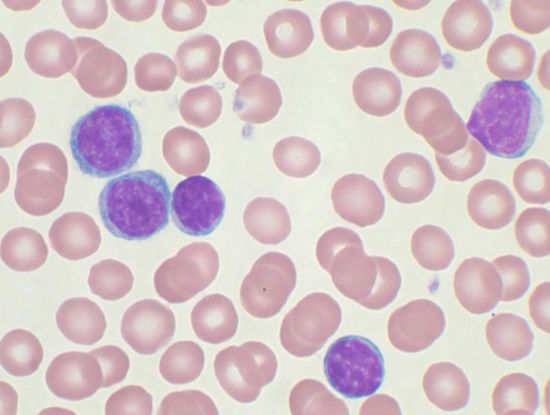 |
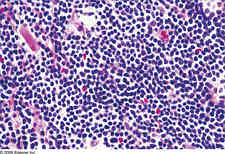 |
| Example morphology of CLL cells in peripheral blood. | Example of SLL in lymph node biopsy |
Immunophenotyping
The CD45 vs SSC/FS gating dot plot shows CLL/SLL cells are CD45 bright and SSC low. These cells are positioned in the same region as normal lymphocytes (red).
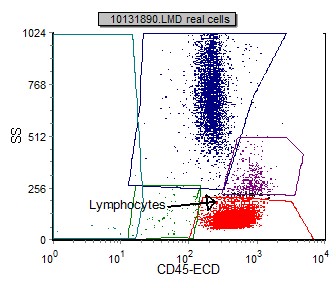 |
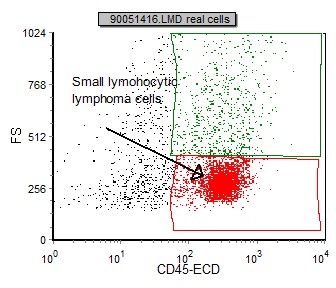 |
| Example CD45 SSC dot plot in a peripheral blood with CLL. | Example CD45 FS dot plot in a fresh lymph node with SLL. |
Below is a table that indicates immunophenotypic expression in CLL/SLL:
| Marker | Expression in CLL/SLL |
| CD5 | + |
| CD10 | - |
| CD11c | +(dim-mod)/- |
| CD19 | +(mod) |
| CD20 | +(dim) |
| CD22 | +(dim) |
| CD23 | +/(rare -) |
| CD25 | +/- |
| CD30 | - |
| CD38 | +/- |
| CD43 | + |
| CD45 | + |
| CD103 | - |
| CD138 | - |
| bcl-1 | - |
| bcl-2 | + |
| bcl-6 | - |
| Light chain Ig (kappa or lambda) | +(dim expression) |
Below are selected dot plots from the above case of CLL:
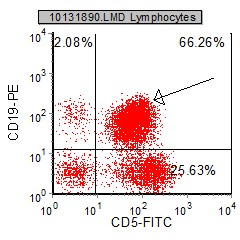 |
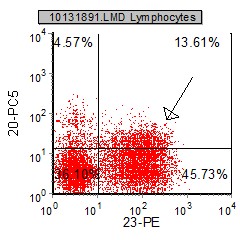 |
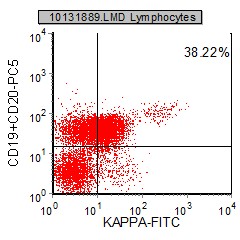 |
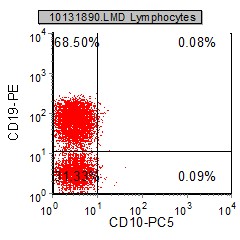 |
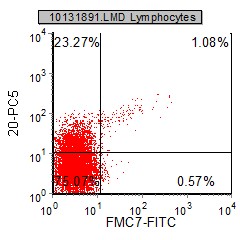 |
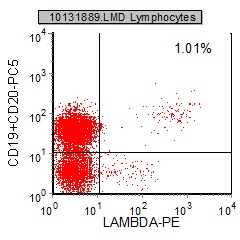 |
| CD19 and CD5 are coexpressed in CLL/SLL. CD10 is negative. | CD20 is dimly expressed and coexpressed with CD23. FMC-7 is negative. | A monoclonal light chain restriction of kappa light chains is dimly expressed. |
Other relevant tests
Addition flow prognostic markers: Since assessment of the IgVH antibody DNA changes is difficult to perform, the presence of either CD38 or ZAP-70 may be surrogate markers of high risk subtype of CLL Their expression correlates with a more immature cellular state and a more rapid disease course.
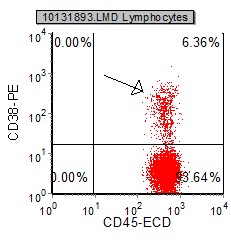 |
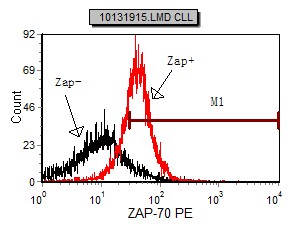 |
| In this CLL case, CD38 is minimazlly expressed. | In this CLL case, Zap 70 is positive. |
Genetics: Recent publications suggest that two or three prognostic groups of CLL exist based on the maturational state of the cell. This distinction is based on the maturity of the lymphocytes as discerned by the immunoglobulin variable-region heavy chain (IgVH) gene mutation status. High risk patients have an immature cell pattern with few mutations in the DNA in the IgVH antibody gene region whereas low risk patients show considerable mutations of the DNA in the antibody gene region indicating mature lymphocytes.
FISH: The following are abnormalities associated with CLL that can provide prognostic information:
- del 17p which target the cell cycle regulating protein p53 are particularly deleterious. Patients with this abnormality have significantly short interval before they require therapy and a shorter survival. This abnormality is found in 5-10% of patients with CLL.
- del 11q are also unfavorable although not to the degree seen with del 17p. The abnormality targets the ATM gene and occurs infrequently in CLL (5-10%).
- Trisomy 12, an additional chromosome 12, is a relatively frequent finding occurring in 20-25% of patients and imparts an intermediate prognosis.
- del 13q is the most common abnormality in CLL with roughly 50% of patients with cells containing this defect. These patients have the best prognosis and most will live many years, even decades, without the need for therapy.
Flow Diagnosis: These cells are CD45 bright and SSC low, express CD19 and CD20 (dim). CD5/CD19 and CD23 are coexpressed and there is a dim monoclonal light chain of either kappa or lambda expressed.
References
1. http://www.ncbi.nlm.nih.gov/pubmed/12406914
2. Ghia P, Guida G, Stella S, et al (2003). "The pattern of CD38 expression defines a distinct subset of chronic lymphocytic leukemia (CLL) patients at risk of disease progression". Blood 101 (4): 1262-9. DOI:10.1182/blood-2002-06-1801. PMID 12406914.
